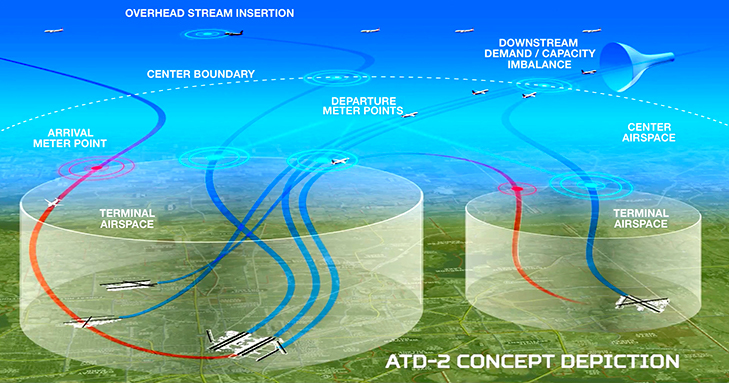 |
ATD-2 Industry Workshop Documentation Outline / High Level Software Description / Fuser Architecture Overview / Fuser Pre-Updaters
Fuser Airport Code Processing
The Fuser uses logic backed by lookup tables to set the ICAO and/or IATA airport codes for each flight.
Summary of ICAO, IATA, and FAA LID Airport Codes
The current Fuser external data sources can send one of three types of airport codes:
- International Civil Aviation Organization (ICAO) airport code: ICAO is a United Nations specialized agency. Most large airports have a code assigned by ICAO. ICAO airport codes are always 4 letters. ICAO codes are commonly used by Air Navigation Service Providers (ANSPs). One major advantage of an ICAO airport code is that the first letter is used to denote the region in the world. The second letter in the code is used to indicate the country (except for the Continental US, Canada, and Australia). Click here for a map of ICAO region codes, or here for a map of ICAO country codes.
- International Air Transport Association (IATA) airport code: IATA is a trade association based in Montreal, Canada. Most large airports have a code assigned by IATA, though there are more airports in the world with ICAO codes than IATA. IATA codes are often used by airlines and they are the code you usually see when booking a flight. IATA airport codes are always 3 letters, and the usually are a closer representation of the name of the city or airport than the ICAO code. The IATA Airline and Airport Code Search page can be used to look up and IATA code.
- FAA Location ID (LID): Every airport in the U.S. has an FAA assigned LID code. This includes small airports, heliports, seaports, etc that do not have either an IATA or ICAO code. FAA LID codes can be either 3 or 4 alphanumeric characters. When an ICAO code exists for a US airport, the FAA LID value is often the last three letters of the code. The FAA website can be used to look up an FAA LID.
Example Airport Codes
Our Fuser lookup table currently includes 26,807 total airports. There are 20,017 FAA LIDs, 9,394 ICAO, and 9,282 IATA codes. The table below provides example of the relationships between the various airport codes:
Airport |
ICAO |
IATA |
FAA LID |
Notes |
Charlotte / Douglas International Airport |
KCLT |
CLT |
CLT |
Simple case where all three codes are similar. |
| Hilton Head Airport |
KHXD |
HHH |
HXD |
IATA code for US airport not the same as FAA LID or ICAO. |
| Allakaket Airport (Alaska) |
PFAL |
AET |
6A6 |
All codes vastly different. |
| Henry County Airport |
KHMP |
|
HMP |
No defined IATA code. |
Livengood Camp Airport |
|
LIV |
4AK |
No defined ICAO code. |
| Pine Valley Border Patrol Station |
|
|
80CN |
No defined IATA or ICAO code. |
| Franz Josef Strauss, Munich International |
EDDM |
MUC |
|
International airport with no FAA LID. |
Fuser External Data Source Airport Code Conventions
Our external data sources only send one airport code. This is the priority used for looking up an airport using the code from each source:
Data Source |
Airport Code Lookup Priority |
| TFMS |
ICAO, FAA LID, IATA |
| TBFM (CAP, SWIM, and IDAC) |
ICAO, FAA LID, IATA |
| Airline Source |
IATA, ICAO, FAA LID |
| 3rd Party Source |
ICAO, FAA LID, IATA |
The Fuser Flight schema currently defines departure and arrival aerodrome elements. The aerodrome element stores an "ICAO", "FAA LID", and an "IATA" code. The convention we use is to create the aerodrome element is defined below:
- Departure/Arrival Aerodrome ICAO Name:
- Use the airport's ICAO code if one is defined.
- If an ICAO code is NOT defined AND the Fuser Flight previously had a defined ICAO code, we store "XXX" as the ICAO code to overwrite the previous ICAO assignment.
- Departure/Arrival Aerodrome IATA Name:
- Use the airport's IATA code if one is defined.
- If an IATA code is not defined, the FAA LID value is used as the IATA code for the aerodrome element.
- If neither an IATA code nor an FAA LID is defined AND the Fuser Flight previously had a defined IATA code for the aerodrome, we store "XXX" as the IATA code to overwrite the previous IATA assignment.
STBO only stores a single departure and arrival airport code per flight, and our adaptation generally uses the IATA codes (e.g. "CLT"). The Fuser Flight aerodrome is converted to a single STBO flight airport using this logic:
- Use the Fuser Flight aerodrome IATA code if it is defined AND is NOT "XXX"
- Otherwise, use the Fuser Flight aerodrome ICAO code.
+ Back to Top |
 |

